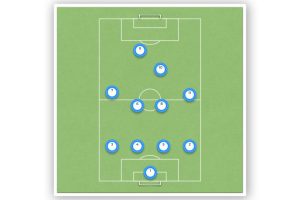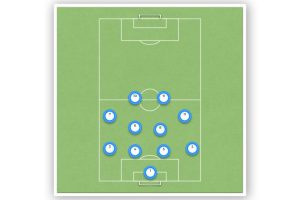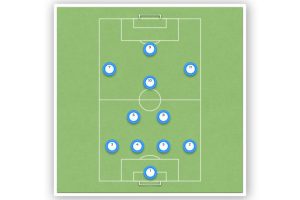Mastering the 3-5-2 Soccer Formation: Tips and Strategies
The 3-5-2 soccer formation (also known as a 5-3-2 depending on if you consider it a back three or back five) is a popular tactical system used by many teams around the world. It is a versatile formation that can be used both offensively and defensively, and it provides a good balance between attack and defense. The formation consists of three central defenders, five midfielders, and two forwards.
The 3-5-2 formation is often used by teams that want to dominate possession and control the midfield. The five midfielders provide a lot of options for passing and moving the ball around the field, while the two forwards can create scoring opportunities and put pressure on the opposing defense. The three central defenders provide a solid defensive foundation, making it difficult for the opposing team to score.
However, the 3-5-2 formation is not without its weaknesses. One of the main challenges is that it requires a lot of discipline and coordination from the players, as they need to constantly adjust their positions and movements depending on the situation on the field. Additionally, the formation can be vulnerable to counterattacks, as the midfielders may be caught out of position when the opposing team regains possession of the ball. Nevertheless, the 3-5-2 formation remains a popular choice for many coaches and teams, and it can be a highly effective way to play soccer.
Overview of the 3-5-2 Formation
The 3-5-2 formation is a popular formation in soccer that has been used by many successful teams. It is a formation that consists of three central defenders, two wing-backs, three central midfielders, and two central strikers. This formation is known for its attacking prowess and its ability to control the midfield. The three central defenders in the 3-5-2 formation are usually positioned in a flat-back three. The central defender is responsible for covering the middle of the pitch, while the left-sided and right-sided central defenders cover the flanks. This formation provides a strong defensive backbone, making it difficult for opposing teams to penetrate the defense.
The two wing-backs in the 3-5-2 formation are responsible for providing width to the team’s attack. They play a crucial role in the team’s attacking strategy, as they are often the ones who provide crosses into the box for the strikers to score.
The wing-backs are also responsible for tracking back and defending when the team loses possession. The three central midfielders in the 3-5-2 formation are positioned in a triangle formation, with one player playing as a defensive midfielder and the other two playing as central midfielders. The defensive midfielder is responsible for breaking up opposition attacks and providing cover for the defense.
The two central midfielders are responsible for controlling the midfield and providing support to the attack. Finally, the two central strikers in the 3-5-2 formation are responsible for scoring goals. They work together to create scoring opportunities and are often the ones who finish off attacking moves. The two strikers are supported by the midfielders, who provide them with the necessary passes and crosses to score.
Overall, the 3-5-2 formation is a well-balanced formation that provides a strong defensive backbone while also allowing for attacking creativity. This formation is known for its versatility and can be adapted to suit different playing styles and opposition teams.
Strengths and Weaknesses of the 3-5-2 Formation
The 3-5-2 soccer formation has gained a lot of popularity in recent years. This formation has proven to be an effective strategy for teams that want to improve their possession, attacking options, and defensive coverage. Additionally, the 3-5-2 formation offers flexibility and adaptability that can be useful in different game situations. In this section, we will explore some of the advantages of the 3-5-2 formation.
Improved Possession and Attacking Options
The 3-5-2 formation is known for its midfield dominance. With five midfielders, this formation allows for better ball control and possession. The two strikers up front can also create more attacking options and pressure on the opposition’s defense. The wing-backs in the 3-5-2 formation can provide width and depth in attack, creating more space for the midfielders to move the ball around. This formation allows for quick transition from defense to offense, making it an effective counter-attacking strategy.
Better Defensive Coverage
The 3-5-2 formation offers better defensive coverage than a traditional 4-4-2 formation. With three center backs, this formation provides a solid defensive core. The wing-backs can also drop back to help defend, making it difficult for the opposition to break through. This formation can be especially effective against teams that rely on a strong attacking presence.
Flexibility and Adaptability
The 3-5-2 formation allows for flexibility and adaptability in different game situations. This formation can be adjusted to suit the team’s needs. For example, the midfielders can be adjusted to create a more defensive or offensive lineup. The wing-backs can also be adjusted to provide more width or to drop back and defend. This formation can be used in different game situations, making it a versatile strategy for teams.
Key Positions and Responsibilities
Central Defenders
The two central defenders in a 3-5-2 formation are responsible for defending the central area of the pitch. They must be strong, quick, and good in the air to deal with aerial threats. They also need to be good at reading the game and anticipating the movements of opposition attackers. In addition to their defensive duties, central defenders also play a key role in starting attacks. They need to be comfortable on the ball and able to pass accurately to the midfielders or forwards.
Wing Backs
The wing backs are arguably the most important players in the 3-5-2 formation. They are responsible for providing width to the team’s attack and defense. They need to be extremely fit, quick, and good dribblers with a decent delivery. In attack, they push forward to provide crosses for the forwards and create chances. In defense, they drop back to form a back five and cover the flanks.
Central Midfielders
The three central midfielders in a 3-5-2 formation are responsible for controlling the midfield. The two central midfielders are often defensive-minded and are tasked with breaking up opposition attacks and protecting the backline. The central attacking midfielder is responsible for linking the midfield and attack, creating chances, and scoring goals. They need to be good passers, have good vision, and be able to shoot accurately from distance.
Forwards
The two forwards in a 3-5-2 formation are responsible for scoring goals and creating chances. They need to be quick, skillful, and have good movement off the ball. They also need to be able to combine well with each other and the midfielders to create goal-scoring opportunities. In addition to their attacking duties, forwards also need to press the opposition defenders when they have the ball to force mistakes and win possession back.
Overall, the 3-5-2 formation is a balanced formation that requires players to have a high level of fitness, tactical awareness, and technical ability. Each player has a specific role and responsibility, and they need to work together as a cohesive unit to be successful.
Read our other formation guides
4-4-2
4-3-3
How to Play the 3-5-2 Soccer Formation
Training and Practice Strategies
To implement the 3-5-2 formation successfully, coaches must develop training and practice strategies that focus on building team cohesion and individual player skills. Coaches should start by emphasizing the importance of communication, as this formation requires players to work together closely and communicate effectively. Coaches can also use training sessions to develop specific skills that are essential for players in this formation, such as the ability to play out from the back, the ability to switch play quickly, and the ability to press high up the field. It is also important to use small-sided games and drills that simulate game-like situations to help players understand their roles and responsibilities within the formation. For example, coaches can use drills that focus on the movement of the wing-backs and central midfielders, as well as drills that focus on the movement of the forwards and central defenders.
In-Game Adjustments and Tactics to play the 3-5-2
Once the team is comfortable with the 3-5-2 formation, coaches can begin to focus on in-game adjustments and tactics.
One of the key strengths of this formation is its flexibility, and coaches should encourage their players to be adaptable and able to change tactics depending on the situation. For example, if the opposition is playing with a lone striker, the team can shift to a 3-4-3 formation by pushing one of the forwards higher up the field. Alternatively, if the opposition is dominating possession, the team can drop deeper and play a more counter-attacking style. It is also important to have a clear plan for how the team will defend and attack in different situations.
Coaches should work with their players to develop a set of principles and guidelines that they can follow in different scenarios. For example, the team may decide to press high up the field when the opposition is playing out from the back, or to drop deep and defend in a low block when the opposition is attacking with pace. Overall, implementing the 3-5-2 formation requires a combination of effective training and practice strategies, as well as a clear plan for in-game adjustments and tactics.
With the right approach, this formation can be a highly effective way to control games and create scoring opportunities.
Conclusion
The 3-5-2 soccer formation can be a very effective way to defend against teams that rely heavily on their forwards to score goals. For example, it is a good strategy against 4-4-2. It is important that all of the players on the team understand their roles and responsibilities within this formation. When executed properly, it can provide a solid defense, while still allowing for attacking options.
One of the strengths of the 3-5-2 formation is the use of wingbacks. The ideal wingback would be very fit, speedy, and a good dribbler with a decent delivery. This position is crucial to the success of the formation, as the strengths of the formation (possession, attacking options, and defensive stability) all derive from the wingback position.
However, it is important to note that the 3-5-2 formation is not without its weaknesses. The defense can be considerably weak in this formation as compared to other formations, such as the 5-2-3. Additionally, the formation can be vulnerable to counterattacks if the wingbacks are caught upfield.
Overall, the 3-5-2 formation can be a valuable tool for coaches and teams looking to add a new dimension to their game. With proper coaching and an understanding of the roles and responsibilities within the formation, it can be an incredibly effective way to play soccer.





